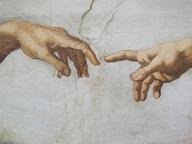Quiz Answer Key and Fun Facts
1. This is one of Michelangelo's earliest pieces of work, completed when he was about seventeen. Titled 'Madonna of the Steps', it is what type of sculpture?
2. Michelangelo carved this piece, his last under the patronage of Lorenzo de' Medici, while he was still a teenager. It was inspired by a Greek myth describing a battle that occurred at the wedding of the Lapith king Pirithous. These half-human, half-horse neighbors are named in the title of the sculpture. What is it called?
3. This marble angel was carved by Michelangelo to be an addition to a larger work commissioned in 1264 by the Dominicans to Nicola Pisano. What is the name of the entire work?
4. Possibly one of the most familiar of Michelangelo's sculptures is this 'Pieta', showing Mary holding the dead body of Christ. Designed in 1499 for the tomb of Cardinal Jean de Bilhères in the Chapel of St Petronilla, where can this masterpiece be found since the middle of the 18th century?
5. At the same time as he was sculpting the famed 'David' (1501-1504), Michelangelo produced this 'Madonna and Child'. The only piece of his sculpture to have left Italy during his lifetime, it is better known as the Madonna of which city?
6. Between 1501 and 1504 Michelangelo added four small statues to the Piccolomini Altarpiece, built twenty years earlier in Siena Cathedral by Andrea Bregno. Which of the four saints, generally considered to be the writer of a large part of the New Testament, is shown here?
7. This statue of a Biblical figure, complete with horns, was constructed to be part of the tomb of Pope Julius II. While the statue was completed within a few years of his death in 1513, the entire tomb was not finished until 1545, and even then it only partially fulfilled Michelangelo's original vision. Who is shown here, holding the Ten Commandments?
8. The tomb of Pope Julius II was a major disappointment for Michelangelo, because the funds necessary to complete the originally-planned project were not finally made available, and it had to be completed on a much smaller scale. Nevertheless, it contains some fine work, including this statue of the first wife of Jacob. What is her name?
9. The Medici Chapel, a mausoleum for members of the Medici family in Florence's Basilica of San Lorenzo, was the first architectural project of Michelangelo. He included four famous reclining figures. Shown here is the tomb of Lorenzo di Piero de'Medici (grandson of the patron of Michelangelo's youth), featuring what two crepuscular figures reclining on the sarcophagus?
10. 'The Deposition', also called 'Bandini Pieta' or 'The Lamentation over the Dead Christ' shows the Virgin Mary, along with two other figures, supporting the dead body of Jesus Christ after the crucifixion. It is Michelangelo's last major project. Who is thought to have been the model for the male figure helping to lift Jesus down into his mother's arms?
Source: Author
looney_tunes
This quiz was reviewed by FunTrivia editor
LadyCaitriona before going online.
Any errors found in FunTrivia content are routinely corrected through our feedback system.


